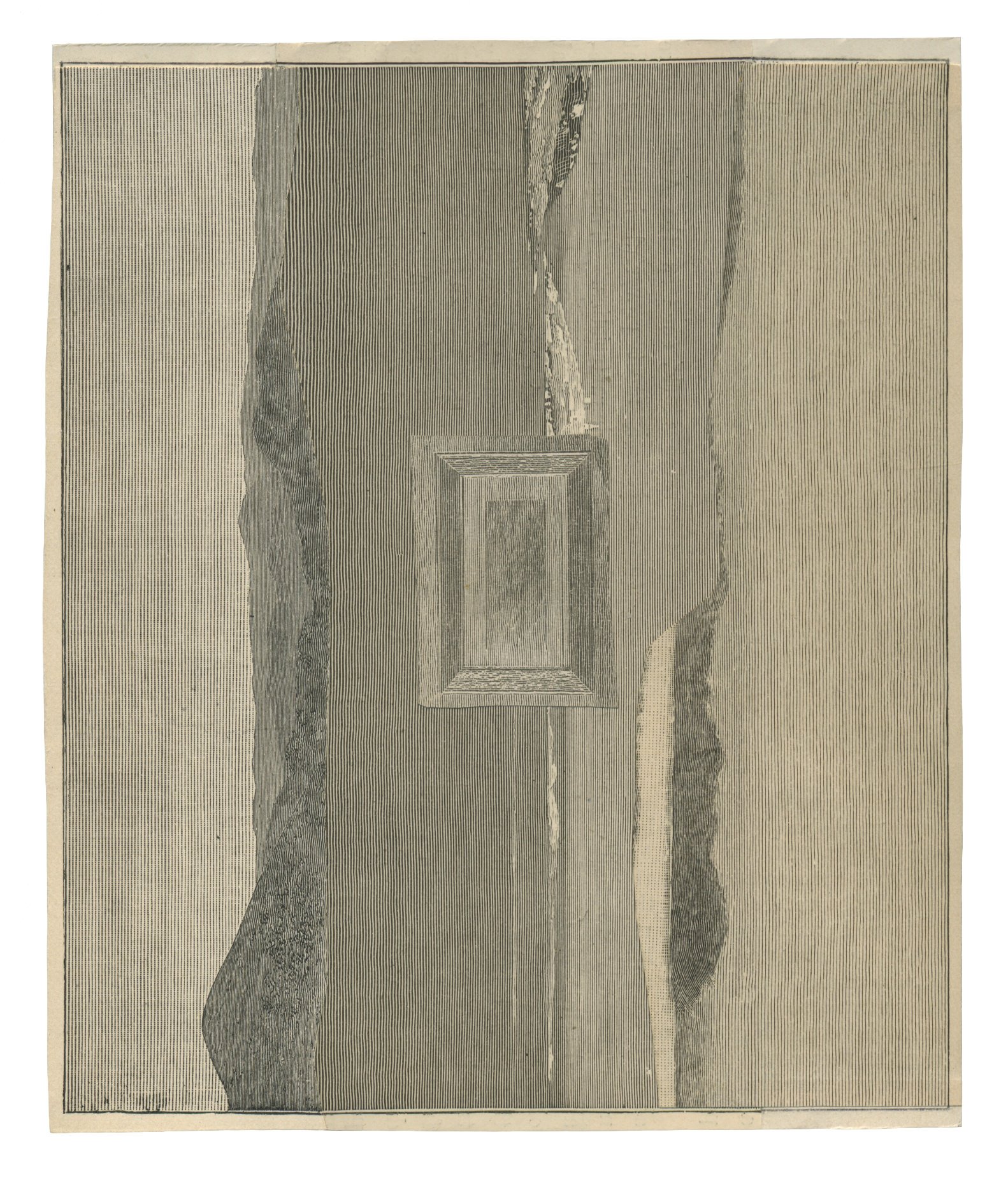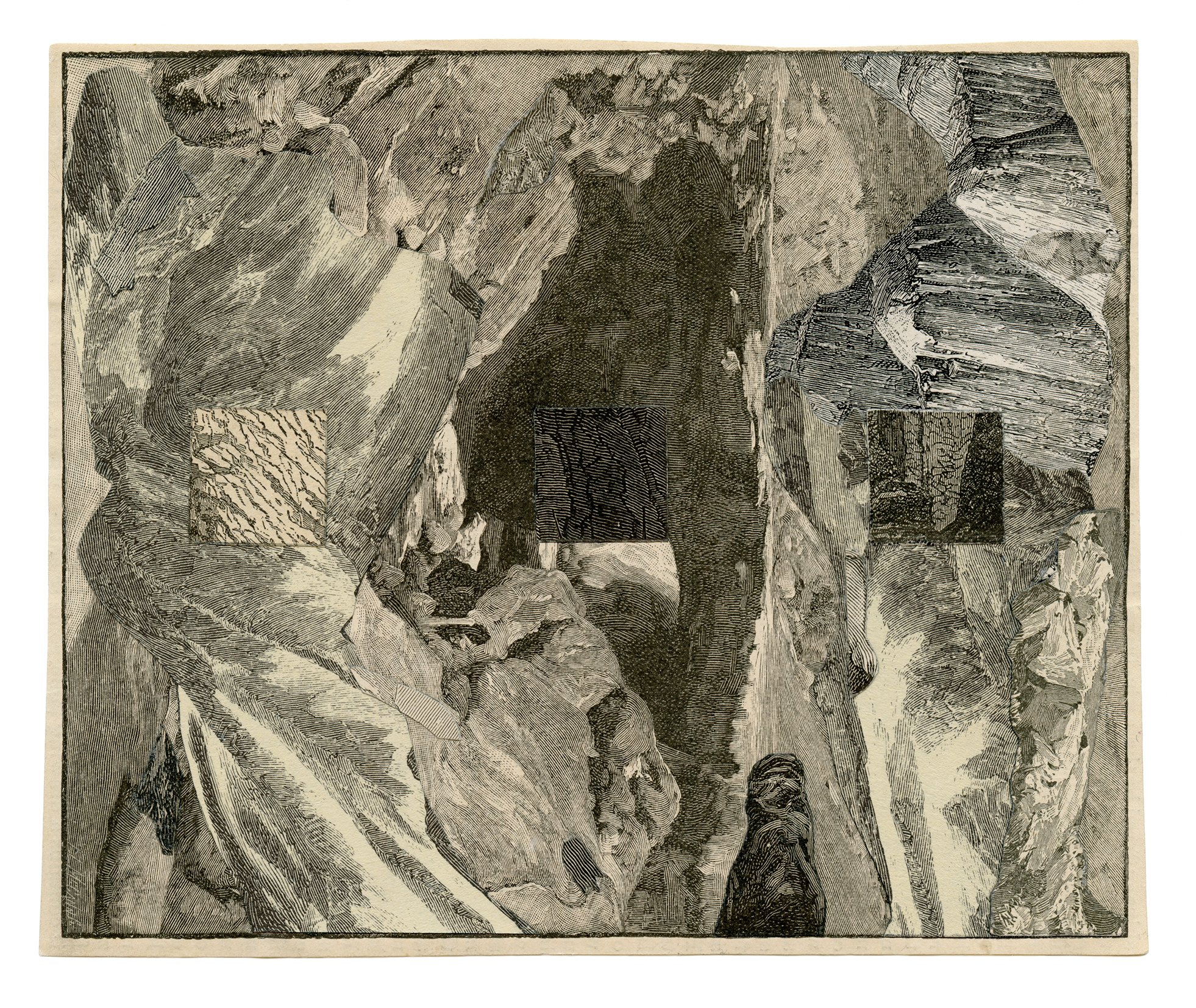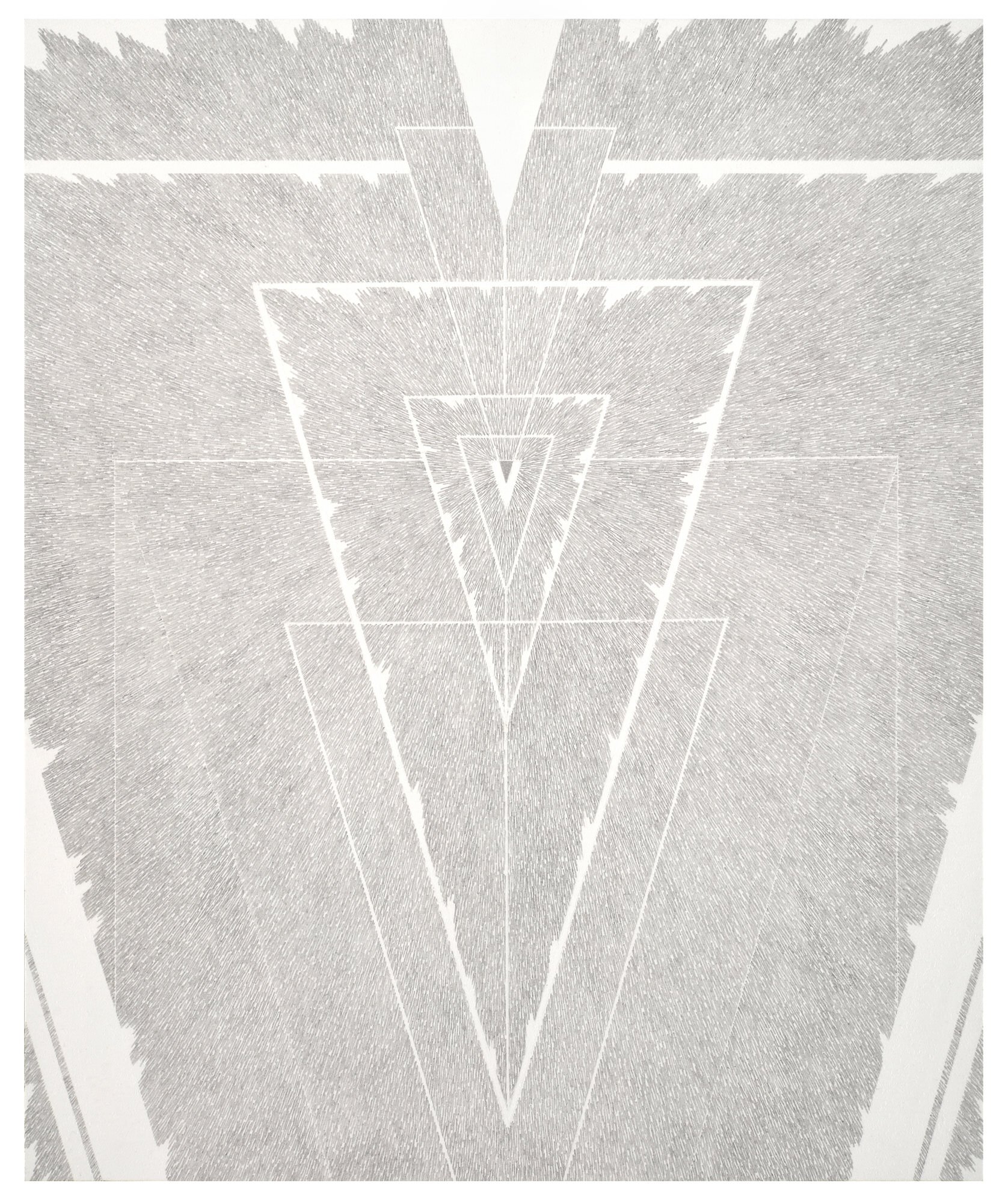
Dean Smith | EXPO Chicago 2023
Eli Ridgway Gallery is pleased to present the work of Dean Smith at EXPO Chicago 2023. Smith’s drawings and collages reflect upon the measure of time and a ceaseless human impulse to render the invisible visible by inviting us to join in a slow, rich meditation on an idea as it unfolds to its conclusion.
“Cerebral decoding of Smith’s art will lead to failure. The longer it is examined, the more allusive—and elusive—it becomes. Collectively weightless, each work breathes as phenomena, as unimaginable and untethered atmosphere, offering a calming respite from certitude—a credit to Smith and his masterful aptitude for abstraction.”
— Rebekah Weikel, Artforum
In Smith’s focusing and diamond net drawings, time is condensed into a series of small energetic staccato marks clustered together and radiating outwards to create a dynamic field of energy. In the careful and determined repetition of making each tiny mark, time is expressed as an energetic performative act; that is, being a record of the artist’s actions and, paradoxically, a visual presentation of the non-visual.
The labyrinth series depicts ahistorical geometric forms drawn precisely, yet delicately, on found vintage paper—time presented both as rumination and physical fact. By their refusal to be specific in their representation, speaking to both past and future structures, these linear shapes become transcendental forms. Like the focusing and diamond net drawings, the labyrinth series is also, paradoxically, a visual presentation of the non-visual.
The environment collage series reflects time in a manner akin to the labyrinth series. Constructed of fragments sourced from 19th century engraving illustrations (originally published in journals such as the London Illustrated News), these collages simultaneously mirror the time of the source material and obfuscate it. While the original pictures were representational (being images meant to illustrate news events or travelogues of the day), the various collaged elements are arranged to abstract rather than reveal their figural nature. What becomes articulated is a space that is deeply oneiric.
Inspired by prions (invasive crystalline protein structures whose turning or folding geometric elements Smith likens to the recombinatory parts of “Transformer” robots), Smith’s thought forms are building blocks of non-living matter which, when combined, speak to the living form of thoughts. His exacting marks imply growth and mutability, while congruently representing the paradox of thinking crystallized. Of these schematizations of the mind’s activity, Smith has said, “Thought is sort of the last stop after the object and before nothingness, and that seems like such an interesting place to be.”
EXPO Chicago | Booth 101
Thursday, April 13 | 12:00noon – 9:00pm
Friday, April 14 | 11:00am – 7:00pm
Saturday, April 15 | 11:00am – 7:00pm
Sunday, April 16 | 11:00am – 6:00pm
Diamond Net
untitled [diamond net_3], 2020, graphite on paper, 11-7/8 x 9-3/4 inches, $3,000. unframed
untitled [diamond net_4], 2020, graphite on paper, 11-7/8 x 9-3/4 inches, $3,000. unframed
untitled [diamond net_5], 2020, graphite on paper, 11-7/8 x 9-3/4 inches, $3,000. unframed
untitled [diamond net_6], 2021, graphite on paper, 11-7/8 x 9-3/4 inches (artwork), 13-3/8 x 11-1/4 inches (frame), $3,500.
untitled [diamond net_7], 2021, graphite on paper, 11-7/8 x 9-3/4 inches (artwork), 13-3/8 x 11-1/4 inches (frame), $3,500.
untitled [diamond net_8], 2021, graphite on paper, 11-7/8 x 9-3/4 inches (artwork), 13-3/8 x 11-1/4 inches (frame), $3,500.
environment
environment #22, 2018, collage of found illustrations, 7-1/2 x 5-1/8 inches, $2,000. unframed
environment #23, 2018, collage of found illustrations, 6-1/2 x 4-3/4 inches, $2,000. unframed
environment #28, 2018, collage of found illustrations, 5-3/4 x 4-3/4 inches, $2,000. unframed
environment #33, 2020, collage of found illustrations, 8-1/4 x 5-7/16 inches (artwork), 13-1/4 x 10-7/16 inches (frame), $2,500.
environment #35, 2020, collage of found illustrations, 7 x 5-7/8 inches (artwork), 12 x 10-7/8 inches (frame), $2,500.
environment #40, 2020, collage of found illustrations, 5 x 6 inches (artwork), 10 x 11 inches (frame), $2,500.
environment #41, 2020, collage of found illustrations, 8-7/8 x 5-7/8 inches (artwork), 13-7/8 x 10-7/8 inches (frame), $2,500.
environment #42, 2020, collage of found illustrations, 6-1/2 x 6-1/2 inches, $2,000. unframed
focusing

focusing #5, 2018, graphite on paper, 33 x 27 inches (artwork), 34-1/2 x 28-1/2 inches (frame), $9,000.

focusing #6, 2018, graphite on paper, 30-1/8 x 24-7/8 inches (artwork), 31-5/8 x 26-3/8 inches (frame), $9,000.

focusing #7, 2022, graphite on paper, 28-1/2 x 23-1/2 inches (artwork), 30 x 25 inches (frame), $9,000.
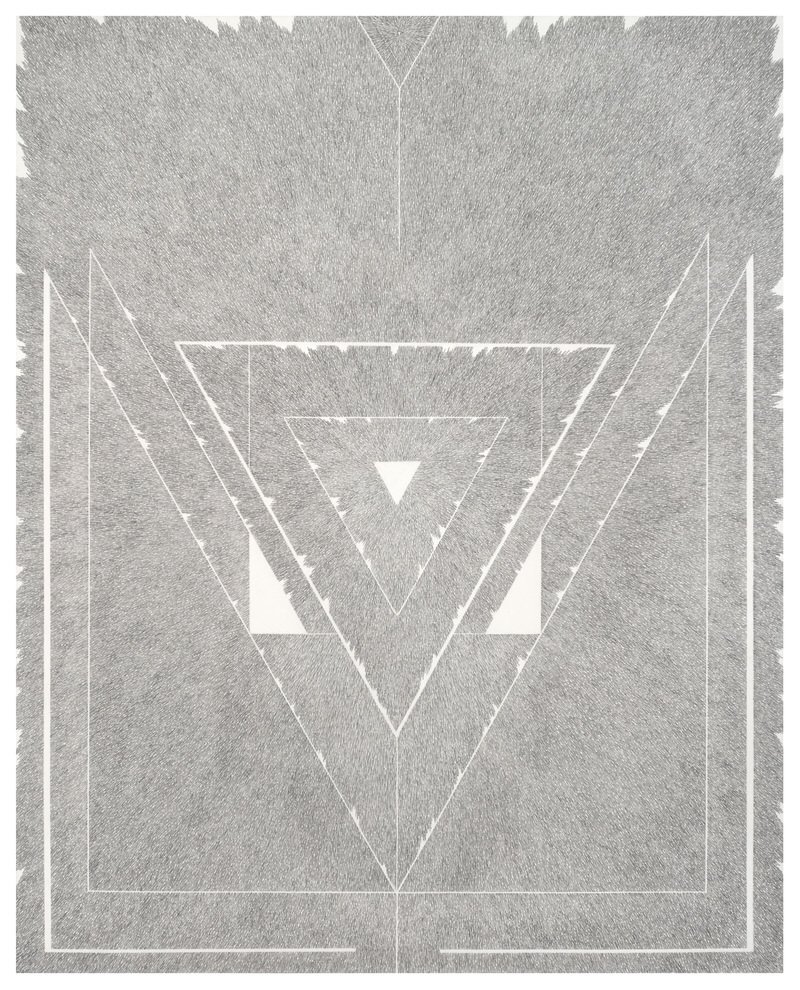
focusing #8, 2022, graphite on paper, 20 x 16 inches (artwork), 22-3/4 x 18-3/4 inches (frame), $4,500.

focusing #9, 2022, graphite on paper, 27-3/4 x 25-1/4 inches (artwork), 30-1/2 x 22-3/4 inches (frame), $9,000.
labyrinth
![untitled [dsl_41] , 2019, graphite on found vintage paper, 11 x 8-1/2 inches (artwork), 16 x 13-1/2 inches (frame), $2,500.](https://images.squarespace-cdn.com/content/v1/5ecee9ac56d36d72f0149f64/eeff31d0-99c0-4dc8-97d7-9ee71009605d/Smith_dsl41_2019.jpg)
untitled [dsl_41], 2019, graphite on found vintage paper, 11 x 8-1/2 inches (artwork), 16 x 13-1/2 inches (frame), $2,500.
![untitled [dsl_42] , 2019, graphite on found vintage paper, 11 x 7-15/16 inches, $2,000. unframed](https://images.squarespace-cdn.com/content/v1/5ecee9ac56d36d72f0149f64/5575df42-294d-4f9b-9973-f84202d59f13/Smith_dsl42_2019.jpg)
untitled [dsl_42], 2019, graphite on found vintage paper, 11 x 7-15/16 inches, $2,000. unframed
![untitled [dsl_44] , 2019, graphite on found vintage paper, 10 x 8 inches, $2,000. unframed](https://images.squarespace-cdn.com/content/v1/5ecee9ac56d36d72f0149f64/985a060d-3bff-4bb1-8b7f-bc353566bdcf/Smith_dsl44_2019.jpg)
untitled [dsl_44], 2019, graphite on found vintage paper, 10 x 8 inches, $2,000. unframed
![untitled [dsl_45] , 2019, graphite on found vintage paper, 10-3/8 x 7-15/16 inches (artwork), 15-3/8 x 12-15/16 inches (frame), $2,500.](https://images.squarespace-cdn.com/content/v1/5ecee9ac56d36d72f0149f64/875a573a-5edb-4c89-bde1-d51fa6dd4f49/Smith_dsl45_2019.jpg)
untitled [dsl_45], 2019, graphite on found vintage paper, 10-3/8 x 7-15/16 inches (artwork), 15-3/8 x 12-15/16 inches (frame), $2,500.
![untitled [dsl_52] , 2019, graphite on found vintage paper, 11 x 7-15/16 inches (artwork), 16 x 12-15/16 inches (frame), $2,500.](https://images.squarespace-cdn.com/content/v1/5ecee9ac56d36d72f0149f64/2e1a5486-ff64-4623-ae9c-1327c12083fa/Smith_dsl52_2019.jpg)
untitled [dsl_52], 2019, graphite on found vintage paper, 11 x 7-15/16 inches (artwork), 16 x 12-15/16 inches (frame), $2,500.
![untitled [dsl_53] , 2019, graphite on found vintage paper, 10-3/8 x 8 inches (artwork), 15-3/8 x 13 inches (frame), $2,500.](https://images.squarespace-cdn.com/content/v1/5ecee9ac56d36d72f0149f64/5878b713-2b4c-4523-a29f-af7fd309d309/Smith_dsl53_2019.jpg)
untitled [dsl_53], 2019, graphite on found vintage paper, 10-3/8 x 8 inches (artwork), 15-3/8 x 13 inches (frame), $2,500.
![untitled [dsl_54] , 2019, graphite on found vintage paper, 11 x 7-7/8 inches, $2,000. unframed](https://images.squarespace-cdn.com/content/v1/5ecee9ac56d36d72f0149f64/dc9083df-e179-4b5f-b539-34787028f2ee/Smith_dsl54_2019.jpg)
untitled [dsl_54], 2019, graphite on found vintage paper, 11 x 7-7/8 inches, $2,000. unframed
![untitled [dsl_55] , 2020, graphite on found vintage paper, 10-3/8 x 7-1/2 inches, $2,000. unframed](https://images.squarespace-cdn.com/content/v1/5ecee9ac56d36d72f0149f64/fff32cb1-4f52-443f-af4d-39310dccbeb9/Smith_dsl55_2020.jpg)
untitled [dsl_55], 2020, graphite on found vintage paper, 10-3/8 x 7-1/2 inches, $2,000. unframed
thought form

thought form #10 (memory), 2006, graphite on paper, 76 x 60 inches (artwork),l 79-5/8 x 63-5/8 inches (frame), $19,500.

thought form #12, 2008, graphite on paper, 50 x 37 inches (artwork), 53-1/4 x 40-1/4 inches (frame), $16,000.
ARTFORUM 2022
Dean Smith | ANGLIM/TRIMBLE
September 6–October 29, 2022
Selections from three bodies of works on paper are featured in Dean Smith’s “The center is the edge of the threshold,” which the Oakland, California–born artist has been diligently refining since the early 2000s.
Drawings from the “labyrinth” series, 2012–, are subtle but striking. On blemished vintage paper are dimensional, diagrammatic forms elegantly rendered in graphite. Rectangular structures appear frequently, suggesting monoliths or portals. On occasion, a faint orange pencil is delicately applied as a framing device that, as we see in untitled [ds_57], 2020, binds a pale, slightly upended cross hovering within a blackened field, inviting the viewer to ponder its glowing and charged presence. This centripetal intensity continues in Smith’s series of graphite “focusing and diamond net” drawings, 2002–, where innumerable tiny staccato marks gravitate toward seemingly magnetic geometric shapes. Given the accretion of time and gesture, these works call to mind the drawings of Vija Celmins, but where her imagery concludes at a pictorial ideal, Smith provides an ideal space for unreachable conclusions.
The “environment” collages, 2014–, integrate fragments of nineteenth-century line-engraved illustrations to create circuitous compositions that evoke—if meticulously subverted and warped—the landscapes of ancient Chinese painters Jing Hao and Guan Tong. Here lie the only perceptible links to reality—take environment #48, 2021, which may or may not incorporate a ladder and the winding branches of an oak. These works also present a concrete signal of the artist and his origins: They are comprised of scrap materials gifted by Bruce Conner’s widow, Jean. Smith was friends with and assisted San Francisco–based Conner in his last years.
Cerebral decoding of Smith’s art will lead to failure. The longer it is examined, the more allusive—and elusive—it becomes. Collectively weightless, each work breathes as phenomena, as unimaginable and untethered atmosphere, offering a calming respite from certitude—a credit to Smith and his masterful aptitude for abstraction.
— Rebekah Weikel
entrance III, 2013
graphite on paper
31¼ x 25 inches (frame: 33½ x 27¼ inches)
Going in: notes on Dean Smith’s
“The center is the edge of the threshold”
by Matt Sussman
The title of this gathering of Dean Smith’s work, “The center is the edge of the threshold,” implies a potentially ceaseless movement inward. Interior becomes exterior becomes interior ad infinitum. Smith’s art frequently exerts just such a centripetal pull on the eye. The longer one looks, the more unstable become the referential or conceptual footholds a viewer might bring to Smith’s work. As Smith put it in an interview with fellow artist Bruno Fazzolari: “My goal is to trip up viewers visually, to get them to ask, ‘What is this?’ And then have them be unable to land on any one specific thing.” Suggestive in its indeterminacy, transfixing in its suggestiveness, Smith’s art offers an occasion for sustained absorption in the bardo between seeing and knowing, abstraction and figuration, the material and the numinous. Comprising recent additions to the growing corpus of diamond net/focusing drawings, environment collages and labyrinth pieces that Smith has steadily added to over the past 15 years, the selection on view here represents a process of continual refinement within each of these discrete bodies of work that has only strengthened their rip tide like pull.
The graphite-on-paper drawings Smith refers to off-handedly as “diamond nets” and “focusing” are exemplary. In these, tiny marks repeat from radial points, their direction and density shifting in accordance with the boundaries created by nested or intersecting shapes – triangles and squares are common forms – that cut across the page. Smith works from a constraint-based process here, laying out certain compositional parameters before undertaking the intensive mark making that fills the spaces he has bounded. Immediately, one is sympathetic to the hours of attention required of the artist to create these pieces. Procedural in origin, these drawings nonetheless eschew any of that word’s lackluster connotations. The diamond net/focusing pieces seem to breathe, rippling with currents of energy. Though resolutely abstract, they inevitably summon eidetic comparisons to both natural phenomena and their representations: the whorls of magnetized iron filings; the synchronous directionality of schools of fish; the tumbling arrows of a wind vector plot.
I think Smith would welcome these associations or their art historical counterparts—a sampling that might include Agnes Denes’ probability pyramids, Karl Blossfeldt’s architectural photographs of dried flora, Yayoi Kusama’s early infinity net canvases, and Bruce Conner’s Rorschach-like inkblot paintings–even if they are only indirectly in play. Similarly, while Smith’s work might, at first glance, be easily be dubbed “psychedelic,” “mystical,” or “cosmological” these terms are not wholly accurate descriptors for what is happening in Smith’s art. Smith is not attempting to visualize expanded consciousness, convey spiritual beliefs, or map astronomical timescales, although he is keenly aware of and deeply interested in how other artists and image-makers across the centuries have set about representing inner experience, the ineffable, or the infinite by way of the crude instruments of our senses.
untitled [dsl_53], 2019
graphite on found vintage paper, 10-3/8 x 8 inches
untitled [diamond net_8], 2021
graphite on paper, 11-7/8 x 9-3/4 inches
Perhaps the most overtly figurative or referential of Smith’s work, his “environment” collages incorporate elements sourced from 19th century line engravings. This was the favored material of Max Ernst and Joseph Cornell and the generation of West Coast artists who followed in their wake – Lawrence Jordan, Jess, Sätty, and of course Conner, whom Smith assisted with making his own collages late in the artist’s life. In fact, Conner’s scraps form the basis for Smith’s collage pieces. Whereas many of these artists worked from the Surrealist’s penchant for unexpected figural juxtapositions, Smith – while certainly self-conscious of the genealogy his work shares – prefers to focus on natural elements. The undulating cliffs, cirrocumulus clouds, and miasmic grasslands he estranges foreground the Moiré effects of the cross-hatchings and shadings that make such elements intelligible. Occasionally, human-made structures (a doorframe, an obelisk) appear as punctuation marks to refocus the eye.
Another series of untitled drawings – Smith calls them “labyrinths,” in passing – are even more enigmatic and absorbing. Unlike the teeming planes of diamond net and focusing drawings or the crosshatched density of the environment collages, here one confronts the shock of negative space. Smith’s graphite and pencil markings on found pieces of honeyed antique paper or panels prepared with gesso are sparse but purposeful, arranged in barely-there rectangular formations suggestive of the floor plan of a church’s nave, circuitry diagrams, or as Smith’s shorthand points to, segments of a larger, erased maze. Some of the drawings incorporate shading and shadow that flirt with dimensionality. What had once been schematics now flicker into portals. The labyrinth series is emblematic of the charge carried across all of Smith’s work. Like the ritual circles drawn by the magus for protection or evocation, Smith’s pieces delimit thresholds of permeability while humming with a power all their own.
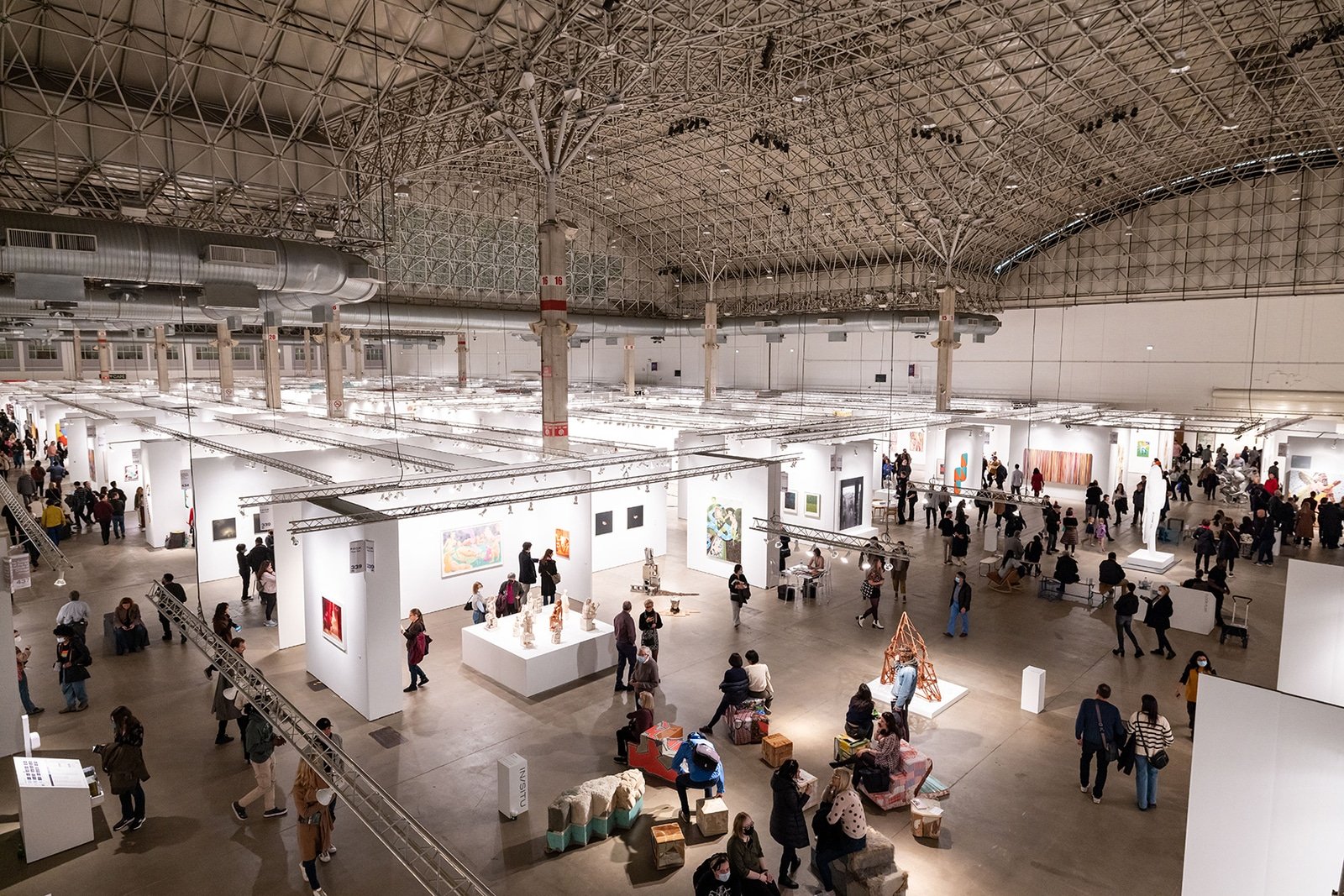
![untitled [diamond net_3] , 2020, graphite on paper, 11-7/8 x 9-3/4 inches, $3,000. unframed](https://images.squarespace-cdn.com/content/v1/5ecee9ac56d36d72f0149f64/e2a3ae55-e08d-4e75-a3a0-c36160a20038/Smith_diamondnet3_2020.jpg)
![untitled [diamond net_4] , 2020, graphite on paper, 11-7/8 x 9-3/4 inches, $3,000. unframed](https://images.squarespace-cdn.com/content/v1/5ecee9ac56d36d72f0149f64/55880ba4-ebd1-4f10-9336-e7de4f23379b/Smith_diamondnet4_2020.jpg)
![untitled [diamond net_5] , 2020, graphite on paper, 11-7/8 x 9-3/4 inches, $3,000. unframed](https://images.squarespace-cdn.com/content/v1/5ecee9ac56d36d72f0149f64/b258c83d-d66d-401a-b5e2-198be314ac35/Smith_diamondnet5_2020.jpg)
![untitled [diamond net_6] , 2021, graphite on paper, 11-7/8 x 9-3/4 inches (artwork), 13-3/8 x 11-1/4 inches (frame), $3,500.](https://images.squarespace-cdn.com/content/v1/5ecee9ac56d36d72f0149f64/0a15d025-a167-47ca-af9e-c7405ae40a3e/Smith_diamondnet6_2021.jpg)
![untitled [diamond net_7] , 2021, graphite on paper, 11-7/8 x 9-3/4 inches (artwork), 13-3/8 x 11-1/4 inches (frame), $3,500.](https://images.squarespace-cdn.com/content/v1/5ecee9ac56d36d72f0149f64/25f2de76-c66d-4335-9a8e-1b4162fdd0df/Smith_diamondnet7_2021.jpg)
![untitled [diamond net_8] , 2021, graphite on paper, 11-7/8 x 9-3/4 inches (artwork), 13-3/8 x 11-1/4 inches (frame), $3,500.](https://images.squarespace-cdn.com/content/v1/5ecee9ac56d36d72f0149f64/67df79bb-f70a-4b80-a17f-952078f84000/Smith_diamondnet8_2021.jpg)


